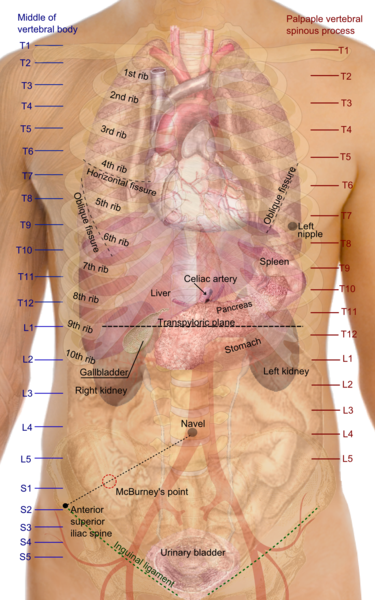Bladder Pain Location and Symptoms
The urinary bladder lies in the lesser pelvis in adults and the lower part of the abdomen in adolescents. When distended, the adult bladder rises into the greater pelvis and in some individuals, it can extend into the lower abdomen. Bladder pain (cystalgia, cystodynia) may arise for a number of reasons including infectious and non-infectious inflammation (cystitis), prolapse (cystocele), bladder stones and tumors.
Bladder conditions may affect surrounding organs and structures or the pain may refer to these areas. In men, the bladder lies above the prostate gland, in front of the rectum and behind the pubic symphysis. In women, the bladder lies below the uterus and peritoneal cavity, in front of the vagina and behind the pubic symphysis. This is discussed further under bladder location.
Location of Bladder Pain
Pain arising from the bladder itself is often described as a deep pain below the umbilicus (belly button), just above or in line with the pubic patch (suprapubic pain) and lying in the midline. Depending on the cause, bladder pain may radiate to the external genitalia, like the penis (men) and vulva (women), to the sides of the abdomen (flanks) and even extending to the back. The bladder lies in line with the lower sacral vertebrae and pain referred to this area may present as lower back pain, at times without pain present elsewhere in the pelvis/lower abdomen.
Picture from Wikimedia Commons
Bladder pain may be vary in character and intensity, from a dull nagging ache to sharp, piercing pain. The pain may exacerbate when :
- bending forward
- bladder is full
- during urination (voiding)
Bladder pain that radiates towards the upper abdomen, sometimes even under the lower ribs, may be due to an infection that has progressed up the ureters to the kidneys. This requires immediate medical attention. Refer to kidney pain location for more information.
Signs and Symptoms Associated With Bladder Pain
The most common cause of bladder pain is a urinary tract infection (UTI) often involving the urethra (urethritis) as well since most infections are bacterial and ascending. Other signs and symptoms may include :
- Pain or burning sensation in the genitalia, especially when urinating, during intercourse and when ejaculating (men).
- Urethral discharge and/or vaginal discharge in women
- Cloudy urine that is strong smelling
- Blood in the urine that may make the urine appear dark yellow to brow, orange or even red.
- Frequent urination
- Persistent urge to urinate
- Urinary incontinence
- Suprapubic pain when defecating (passing stool)
Straining to urinate, hesitancy and post-micturition dribble may indicate the involvement of the prostate gland (prostatitis) in men. Fever, chills, malaise and nausea are indicative of a severe infection. Unintentional weight loss associated with bladder pain may be due to bladder cancer.
Other related articles :






